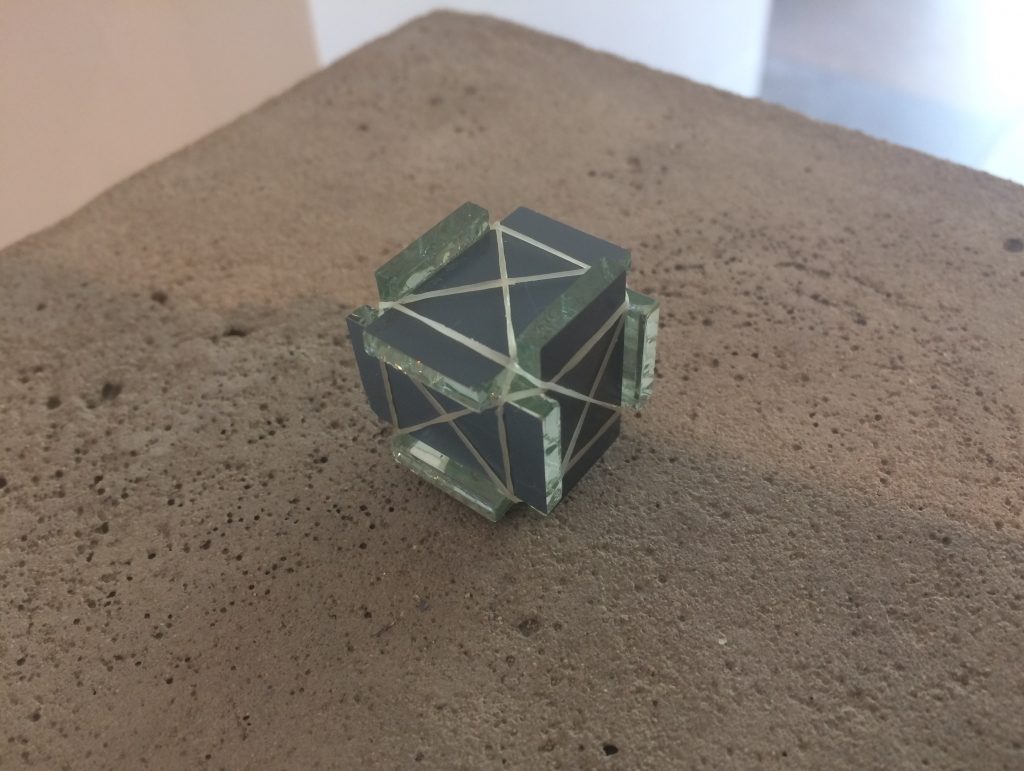
2.6cm³ (infinity cube), 20cm x 20cm x 80cm (concrete plinth)
Mirrors, orthodontic bands, concrete
In 2016, my sculptural language started to become bent out of shape.
Striving to build a monumental mountain, assembled using ill-fitting items became the tipping point.
Engorged by my failed mountain, as it collapsed and concertina around me, my impossible performance became a confrontation of reaching a limit.
Reading Rudolf Arnheim’s essay ‘The Echo of the Mountain’ from ‘The Split and the Structure’; a collection of 28 essays published in 1996, my un-mountain, titled ‘Gorge’, 2016, began to echo Arnheim’s analogy of ow an art work has the ability to reflect the ‘impediments of the body’ and ‘the ease of the mind’s mobility’. [1]
Several months after my encounter with an un-mountain, I was invited to exhibit in a group show, titled ‘Punctuated³’.
Thinking I had drawn the short straw when allocated the smallest space with a mere 2.6cm³ dimensions, when my practice, at that time, was about pushing the limits of scale, during the lead up to this exhibition I was fortunate to witness one of Pistoletto’s ‘Metrocubo d’infinito’, which was exhibited in ‘John Latham’s: A Lesson in Sculpture’, at The Henry Moore Institute, in 2017.
Formed using only two materials; mirrors and rope, and constructed with minimal intervention, yet one profoundly enigmatic act; six mirrored surfaces facing inwards, within its dimensions of 120cm height by 120cm width by 120cm depth it held an unseen, metre cubed interior chamber that harnessed infinity.
Back in 1967, Gemano Celant defined Italian Arte Povera [2] as a time when ‘iconographic conventions’ were ‘collapsing’ and ‘symbolic and conventional languages’ were ‘crumbling’ [3]. Possibly the last or one of the last 20th century art movements that marked the collapse of conventions back in ’67, appeared in the form of an echo that reverberated through time and space, to the present moment, as if to speak to my sculptural predicament, on how to exceed the limitations of a mere 2.6cm³ space?
Unlike phenomena that is perceived through the senses, in Immanuel Kant’s ‘Critique of Pure Reason’ from 1781, he defines ‘noumena’ as objects of inquiry that require the act of thought. Though the limitless space of Pistoletto’s infinity chamber is not visible and only comes to mind if the material association is made, could Pistoletto’s infinity cube be positioned somewhere between a phenomenon and a noumenon, since it points to what is not shown from what is shown?
My interpretation of Pistoletto’s ‘Metrocubo d’infinito’ is a fusion of manual and intellectual forms of dexterity that are enmeshed, and both require to be flexed to appreciate the unseen from what can be seen. Perhaps this loosely constructed work could be considered as an act of (re)formation, wherein, the value of physical and intellectual forms of labour are reconsidered.
Though my reinterpretation of Pistoletto’s metre infinity cube had to be concentrated to meet the constraints of the space allocated to me, ‘Concentrate’, 2017, harnessed an equally infinite interior as Pistoletto’s original.
While scaling down Pistoletto’s cube and replacing the rope with orthodontic bands that degrade over time, it took approximately 4 years for the orthodontic bands to breakdown the intrinsic value of the hidden, infinite space.
[1] Rudolph Arnheim. ‘The Split and the Structure’. University of California Press. 1996. p92-96
[2] Museum of Modern Art (MOMA): New York City. (n.d.) Arte Povera. Retrieved from: https://www.moma.org/collection/terms/arte-povera. Source cited: 20th August, 2022
A movement of young Italian artists who attempted to create a new sculptural language through the use of humble, everyday materials. Meaning “poor art,” the term was introduced in 1967 by Italian art critic and curator Germano Celant to describe the work by these artists. In them, Celant found a shared revolutionary spirit inextricably linked to the increasingly radical political atmosphere in Italy at the time. By using non-precious and impermanent materials such as soil, rags, and twigs, Arte Povera artists sought to challenge and disrupt the commercialization of art.
[3] Extract from the text originally published in the exhibition catalogue Galleria La Bertesca: Genoa. (1967) Arte povera – Im Spazio, in Germano, Celant et al. (2000) Arte povera in collezione (Arte povera in collection), Milano: Charta, pp. 27-28